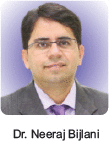The landscape of AI (Artificial Intelligence) and specifically AI in healthcare is growing rapidly. Although most of these are focussed on complex issues of imaging and planning, we came up with the idea of impacting the very foundation of Clinical Decision Making by using the AI Technology. OrthoAI is a product of this thought process and was launched on 11th Dec 2023 at the hands of Dr Raghunath Mashelkar eminent scientist from India. It was an amazing event structured around the World’s First AI Focussed on Orthopaedics. OrthoAI, or OrthoGPT, is designed to transform clinical decision-making with its sophisticated database and advanced AI capabilities.
OrthoAI: A Generative AI Revolution in Orthopaedics
We believe OrthoAI is the foundation of the AI Revolution in Orthopaedics, and we would like to share some more insights about it. OrthoAI primarily is a Generative AI like chat GPT. You can even call it OrthoGPT (Ortho Generative Pre-trained Transformer), a type of artificial intelligence model designed for understanding and generating human-like text. OrthoAI, akin to a specialized version of Chat GPT, or ’OrthoGPT’, stands on three foundational pillars:
The OrthoAI Database: The essence of OrthoAI lies in its meticulously curated vector database, developed over nine months by a team of expert orthopaedic surgeons. This database is the cornerstone of OrthoAI’s reliability and validation.
PubMed Access: OrthoAI’s integration with PubMed enriches its evidence base, ensuring that its responses are grounded in the latest orthopaedic literature.
OrthoTV Access: With over eleven thousand orthopaedic videos, OrthoTV provides a wealth of expert knowledge and experiences. OrthoAI’s access to this repository allows it to offer comprehensive answers, supplemented with relevant article links and video content
At its core, AI involves creating computer systems that mimic human intelligence, enabling them to perform tasks that usually require human intellect.
OrthoAI is equipped with following AI Core functions
Machine Learning (ML) is a subset of AI that allows computers to learn and improve from experience without being explicitly programmed
Deep Learning (DL) is a more complex subset of ML that mimics the neural networks of our brain. DL involves feeding a computer system a vast amount of data, which it uses to make decisions. This ability to process and analyse a significant amount of data makes DL particularly valuable for OrthoAI.
Natural Language Processing (NLP) can read and understand human language, enabling it to extract essential information from clinical notes or respond to patient queries in real-time. OrthoAI has NLP built in and will continue to learn from all its interactions.

We believe the most important area of impact of OrthoAI will be Clinical Decision Making. OrthoAI as discussed above is built on a validated database, along with PubMed and OrthoTV access. This makes the answers most relevant and trustworthy. With a synthesised answer from all sources, it will be source of having a huge thinking knowledge bank at your fingertips. It will act as CO-PILOT or as EBM Assistant to Orthopaedic Surgeons, helping them in tricky situations. The queries can vary from clinical, academic, case based, surgical steps, drug interactions, rehabilitation, complications, and surgical planning too. This is the version 1, and more things would be added in coming versions
We will urge all readers to visit OrthoAI on www.orthoai.in webportal or scan the code to access the portal
Conclusion
OrthoAI is launched at the threshold of a new era in orthopaedics, bringing significant improvements in diagnosis, treatment planning, surgical execution, prosthetics, rehabilitation, and predictive analytics. As we start to incorporate AI more comprehensively into our practice, we need to conscientiously navigate the ethical and legal challenges it presents. Our enthusiasm as technologically inclined orthopaedic surgeons drives us to harness OrthoAI’s full potential, ushering in an era of precision, efficiency, and patient-centric care in orthopaedics.
Biography





Footnotes
Conflict of Interest: Nil
Source of Support: Nil
Consent: The authors confirm that informed consent was obtained from the patient for publication of this case report


